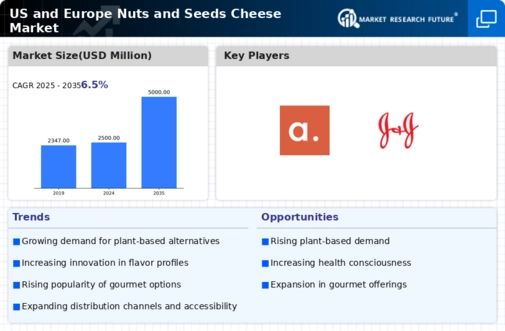Market Trends
Key Emerging Trends in the US Europe Nuts Seeds Cheese Market
The United States and Europe have witnessed a notable increase in the number of individuals experiencing lactose intolerance. Lactose intolerance is characterized by the absence of the enzyme lactase in the small intestine, crucial for breaking down lactose into simpler sugars. Affected individuals may exhibit allergic reactions to dairy products, encounter deficiencies in disaccharides, or suffer from a lack of lactase. The consequences of undigested or partially digested lactose include abdominal bloating, stomach pain, diarrhea, fatigue, sleep disturbances, vomiting, and various other health issues. The prevalence of lactose intolerance displays variations among ethnicities. According to The Eunice Kennedy Shriver National Institute of Child Health and Human Development, an estimated 30 million to 50 million adults in the US grapple with lactose intolerance. This condition is not exclusive to the US, as Europe also reports a significant number of individuals experiencing lactose intolerance. The issue is particularly pronounced in Western European countries, with a notable concentration in the UK, France, and Italy. Consumers in these regions often choose lactose-free alternatives over lactose-enriched food and beverages.
The European Dairy Association highlights the substantial impact of lactose intolerance in the UK, France, and Italy. Notably, around 15% of French consumers allocated an individual monthly expenditure of approximately EUR 12 (around USD 13) in 2019 for lactose-free food and beverages. This consumer behavior has triggered an increased demand for nut and seed-based cheese in both the US and Europe. The rising prevalence of lactose intolerance is expected to be a significant driver for the growth of the nuts and seeds cheese market in the US and Europe during the forecast period from 2020 to 2026.
As lactose-intolerant individuals seek alternatives to traditional dairy products, the market for nuts and seeds cheese is positioned to capitalize on this trend. Nut and seed-based cheeses offer a viable solution for those looking to enjoy cheese-like products without the discomfort associated with lactose-containing options. These alternatives cater to the dietary preferences and health-conscious choices of lactose-intolerant consumers in both the US and Europe.
The forecasted period, spanning from 2020 to 2026, is anticipated to witness sustained growth in the nuts and seeds cheese market, driven by the increasing number of individuals with lactose intolerance. This trend not only reflects a shift in consumer preferences but also represents an opportunity for market players to innovate and expand their offerings to meet the rising demand for lactose-free alternatives. The growth trajectory of the nuts and seeds cheese market is poised to align with the evolving dietary landscape shaped by the prevalence of lactose intolerance in the US and Europe.





Leave a Comment